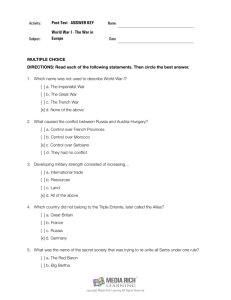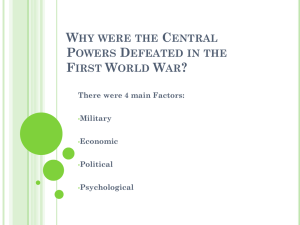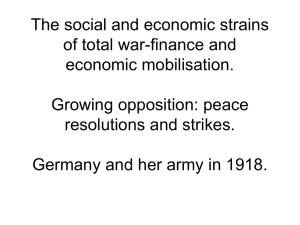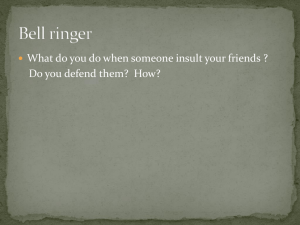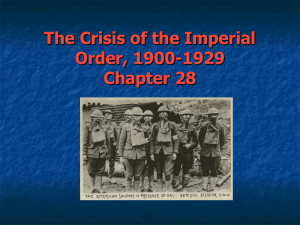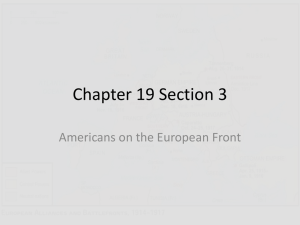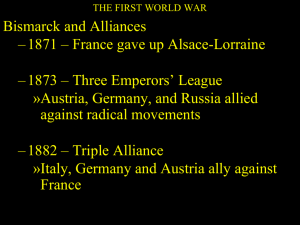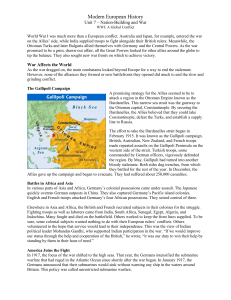29-3-A_Global_Conflict
advertisement
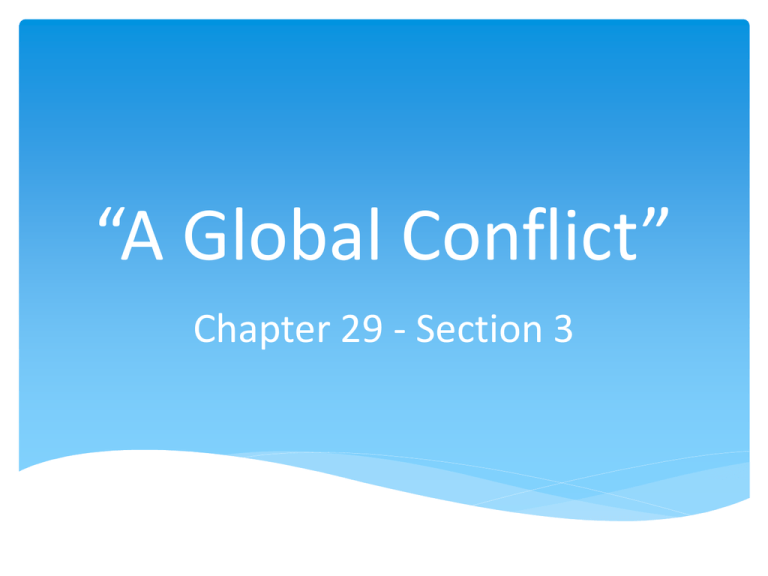
“A Global Conflict” Chapter 29 - Section 3 Introduction World War I was much more than a European conflict Australia and Japan, for example, entered the war on the Allies’ side, while India supplied troops to fight alongside their British rulers. Meanwhile, the Ottoman Turks and later Bulgaria allied themselves with Germany and the Central Powers. As the war promised to be a grim, drawn-out affair, all the Great Powers looked for other allies around the globe to tip the balance. They also sought new war fronts on which to achieve victory. War Affects the World The Gallipoli Campaign Allies move to capture Ottoman Dardanelles strait in February 1915. Hope to defeat the Ottoman Empire, a Central Powers ally. Also want to open a supply line through region to Russia. Effort ends in costly Allied defeat. The Gallipoli Disaster, 1915 War Affects the World Battles in Africa and Asia Allies take control of German holdings in Asia and Africa. Britain and France use their colonial subjects to help in war effort Sikh British Soldiers in India Fighting in Africa Black Soldiers in the German Schutztruppen [German E. Africa] British Sikh Mountain Gunners Fighting in Africa 3rd British Battalion, Nigerian Brigade War Affects the World America Joins the Fight Germany seeks to control Atlantic Ocean to stop supplies to Britain. Germany uses unrestricted submarine warfare, and ship near Britain are sunk without warning. Germany halts this policy in 1915 after the sinking of the Lusitania angers the United States RMS Lusitania arriving in New York on her maiden voyage arriving in New York in September 1907. Upon its sinking by a German U-boat on May 7, 1915, 1,198 people died when the ship went down. The Sinking of the Lusitania War Affects the World Germany renews unrestricted policy in 1917 in hopes to starve Britain quickly. Renewal of policy angers the United States. Zimmermann Telegram—effort to enlist Mexico in war against the United States—angers the United States. The United States declares war against Germany in April 1917 joining the Allies. The Zimmerman Note War Affects the Home Front Governments Wage Total War World War I becomes a “total war”—nations devote all resources to war. Governments take control of the economy to produce war goods. Nations turn to rationing—limiting purchases of warrelated goods. Propaganda—one sided information to build morale and support for the war. Australian Poster American Poster Financing the War German Poster Think of Your Children! War Affects the Home Front Women and the War At home, thousands of women fill jobs previously held by men. Many women also experience the war by working as nurses. Financing the War For Recruitment Munitions Workers French Women Factory Workers German Women Factory Workers Working in the Fields A Woman Ambulance Driver Red Cross Nurses Women in the Army Auxiliary Russian Women Soldiers Spies “Mata Hari” Real Name: Margareetha Geertruide Zelle Double-Agent? 1918 Flu Pandemic: Depletes All Armies 50,000,000 – 100,000,000 died The Allies Win the War Russia Withdraws Civil unrest in Russia forces Czar to step down from throne in 1917. Communists soon take control of Russia’s government. Russia signs a treaty with Germany in March 1918, pulls out of war. The Allies Win the War The Central Powers Collapse With Russia gone, Germany moves most forces to Western Front Engage in major fighting; Allies force Germans to retreat. Allies win war; armistice—end of fighting—signed November 1918. 11 a.m., November 11, 1918 The Armistice is Signed! The Legacy of the War A High Price War takes heavy toll; 8.5 million soldiers dead, 21 million wounded War devastates European economies, drains national treasuries. Many acres of land and homes, villages, towns destroyed. Survivors suffer disillusionment and despair; reflected in the arts. “A Street in Arras” John Singer Sargent, 1918 “Oppy Wood” – John Nash, 1917 “Those Who Have Lost Their Names” Albin Eggar-Linz, 1914 “Gassed and Wounded” Eric Kennington, 1918 “Paths of Glory” C. R. W. Nevinson, 1917
